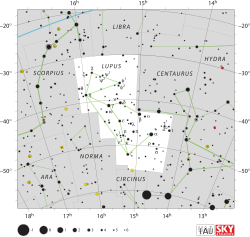Star in the constellation Lupus
For other stars with this Bayer designation , see ξ Lupi .
Xi Lupi (ξ Lup, ξ Lupi) is a member of a double star with Xi Lupi in the southern constellation of Lupus . As of 2004, the pair had an angular separation of 10.254 arcseconds along a position angle of 49.21°. Xi Lupi is visible to the naked eye with an apparent visual magnitude of 5.55. Based upon an annual parallax shift of 21.71 mas as seen from Earth, it is located roughly 150 light-years from the Sun . It has a peculiar velocity of 14.3±1.9 km/s relative to its neighbors, and is probably (86% chance) a runaway star .
This is a B-type main-sequence star with a stellar classification of B9 V. It has an estimated 2.38 times the mass of the Sun and radiates 10.6 times the Sun's luminosity from its outer atmosphere at an effective temperature of 9,725 K . Xi Lupi is about 381 million years old and is spinning relatively rapidly with a projected rotational velocity of 184 km/s.
References
^ van Leeuwen, F. (2007), "Validation of the new Hipparcos reduction", Astronomy and Astrophysics , 474 (2): 653–664, arXiv :0708.1752 , Bibcode :2007A&A...474..653V , doi :10.1051/0004-6361:20078357 , S2CID 18759600 .
^ Høg, E.; et al. (2000), "The Tycho-2 catalogue of the 2.5 million brightest stars", Astronomy and Astrophysics , 355 : L27, Bibcode :2000A&A...355L..27H , doi :10.1888/0333750888/2862 .
^ Levato, H. (January 1975), "Rotational velocities and spectral types for a sample of binary systems", Astronomy and Astrophysics Supplement Series , 19 : 91–99, Bibcode :1975A&AS...19...91L .
de Bruijne, J. H. J.; Eilers, A.-C. (October 2012), "Radial velocities for the HIPPARCOS-Gaia Hundred-Thousand-Proper-Motion project", Astronomy & Astrophysics , 546 : 14, arXiv :1208.3048 , Bibcode :2012A&A...546A..61D , doi :10.1051/0004-6361/201219219 , S2CID 59451347 , A61.
^ David, Trevor J.; Hillenbrand, Lynne A. (2015), "The Ages of Early-Type Stars: Strömgren Photometric Methods Calibrated, Validated, Tested, and Applied to Hosts and Prospective Hosts of Directly Imaged Exoplanets", The Astrophysical Journal , 804 (2): 146, arXiv :1501.03154 , Bibcode :2015ApJ...804..146D , doi :10.1088/0004-637X/804/2/146 , S2CID 33401607 .
^ McDonald, I.; et al. (2012), "Fundamental Parameters and Infrared Excesses of Hipparcos Stars", Monthly Notices of the Royal Astronomical Society , 427 (1): 343–57, arXiv :1208.2037 , Bibcode :2012MNRAS.427..343M , doi :10.1111/j.1365-2966.2012.21873.x , S2CID 118665352 .
"ksi02 Lup" . SIMBAD Centre de données astronomiques de Strasbourg . Retrieved 2017-03-08.Eggleton, P. P.; Tokovinin, A. A. (September 2008), "A catalogue of multiplicity among bright stellar systems", Monthly Notices of the Royal Astronomical Society 389 (2): 869–879, arXiv :0806.2878 , Bibcode :2008MNRAS.389..869E , doi :10.1111/j.1365-2966.2008.13596.x , S2CID 14878976 .
Sinachopoulos, D.; et al. (September 2007), "CCD astrometry and components instrumental magnitude difference of 432 Hipparcos wide visual double stars", Astronomy and Astrophysics , 472 (3): 1055–1057, Bibcode :2007A&A...472.1055S , doi :10.1051/0004-6361:20066290 , hdl :11427/35072 .
Tetzlaff, N.; et al. (January 2011), "A catalogue of young runaway Hipparcos stars within 3 kpc from the Sun", Monthly Notices of the Royal Astronomical Society , 410 (1): 190–200, arXiv :1007.4883 , Bibcode :2011MNRAS.410..190T , doi :10.1111/j.1365-2966.2010.17434.x , S2CID 118629873 .
Categories :
Text is available under the Creative Commons Attribution-ShareAlike License. Additional terms may apply.
**DISCLAIMER** We are not affiliated with Wikipedia, and Cloudflare.
The information presented on this site is for general informational purposes only and does not constitute medical advice.
You should always have a personal consultation with a healthcare professional before making changes to your diet, medication, or exercise routine.
AI helps with the correspondence in our chat.
We participate in an affiliate program. If you buy something through a link, we may earn a commission 💕
↑
